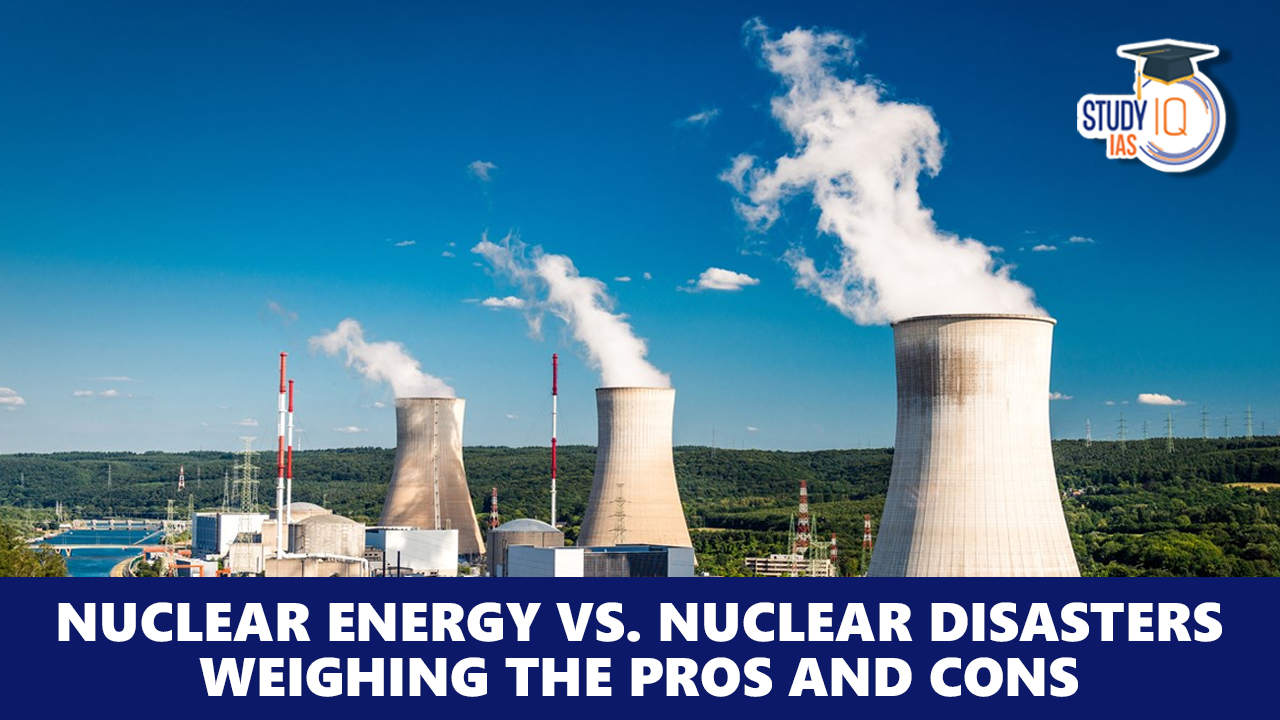Table of Contents
Context: Bellona Foundation, a Lithuania-based NGO has published a report analyzing the risks associated with the hostilities around the Zaporizhzhia Nuclear Power Plant (NPP) in Ukraine.
About the Zaporizhzhia Nuclear Power Plant (NPP)
- The Zaporizhzhia NPP in southeastern Ukraine is the largest nuclear power plant in Europe and among the 10 largest in the world.
- It is located on the banks of the Dnieper river, which is the longest river of Ukraine and Belarus and the fourth-longest river in Europe, after the Volga, Danube, and Ural rivers.
- The Zaporizhzhia NPP has been under Russian occupation since March 2022.
- The main concern identified in the Bellona report is the risk of a complete containment breach and a projectile striking a reactor while it is generating power. This scenario could lead to the release of radioactive materials and volatile substances into the air, including iodine-131 and cesium-137.

About Nuclear Energy
- Nuclear energy is a type of energy that is generated by the process of nuclear reactions- either nuclear fission or nuclear fusion.
- The energy released during these reactions can be harnessed and used to produce electricity, heat, or other forms of energy.
- Nuclear fission: It is a process in which the nucleus of an atom is split into two or more smaller nuclei, releasing a large amount of energy in the process.
- This process is used in nuclear power plants to generate electricity.
- One example of nuclear fission is the reaction that occurs in a nuclear reactor when uranium atoms are split into smaller atoms.
- Nuclear fusion: It is a process in which two or more atomic nuclei come together to form a single, more massive nucleus, releasing a large amount of energy in the process.
- This process occurs naturally in stars, including our own sun.
- One example of nuclear fusion is the reaction that occurs in a hydrogen bomb.
Advantages of Nuclear Energy

India and Nuclear Energy
- Nuclear power is the fifth-largest source of electricity in India after coal, gas, hydroelectricity and wind power.
- As of 2020, India has 22 nuclear reactors in operation in 8 nuclear power plants, with a total installed capacity of 7,380 MW. 10 more reactors are under construction with a combined generation capacity of 8,000 MW.
- India has around 1–2% of the global uranium reserves, while thorium reserves are bigger; around 12–33% of global reserves, according to IAEA and US Geological Survey.
India’s Three-Stage Nuclear Power Programme
- India’s three-stage nuclear power programme was formulated by Homi Bhabha in the 1950s to secure the country’s long term energy independence, through the use of uranium and thorium reserves.
- The ultimate focus of the programme is on enabling the thorium reserves of India to be utilized in meeting the country’s energy requirements.
- Stage I – Pressurized Heavy Water Reactor [PHWR]:
- The first stage of India’s nuclear program involves the use of PHWRs fuelled by natural uranium.
- These reactors generate electricity while also producing plutonium-239 as a by-product.
- Stage II – Fast Breeder Reactor (FBR):
- The second stage of India’s nuclear program involves the use of FBRs fuelled by a mix of plutonium-239 and uranium-238.
- These reactors generate more plutonium-239 than they consume and can also convert thorium into uranium-233, which can be used as fuel in the third stage.
- Stage III – Thorium Based Breeder Reactors:
- The third and final stage of India’s nuclear program involves the use of thorium-based reactors fuelled by uranium-233 produced in FBRs.
- These reactors are designed to use thorium as a fuel, which is abundant in India, and have the potential to provide a sustainable source of nuclear energy for the country.
What are Nuclear Disasters?
- Nuclear disasters refer to catastrophic incidents that involve the release of significant amounts of radioactive materials into the environment due to accidents or failures in nuclear facilities.
- These disasters can have severe consequences for human health, the environment, and social and economic well-being.
Few Notable examples of Nuclear Disasters
- Chernobyl Disaster (1986): It is considered one of the most devastating nuclear accidents in history. It occurred at the Chernobyl Nuclear Power Plant in Ukraine (then part of the Soviet Union). A combination of design flaws, operator errors, and a steam explosion resulted in a fire that burned for several days, releasing large amounts of radioactive materials into the atmosphere. The accident caused immediate deaths, acute radiation sickness in workers, and long-term health effects in nearby populations. It also led to the contamination of extensive areas with radioactive fallout.
- Fukushima Daiichi Disaster (2011): The Fukushima Daiichi nuclear disaster occurred following a massive earthquake and tsunami in Japan. The disaster affected the Fukushima Daiichi Nuclear Power Plant, leading to multiple reactor meltdowns, hydrogen explosions, and the release of radioactive materials. It resulted in the evacuation of surrounding areas, contamination of soil and water, and long-term concerns about the health effects of radiation exposure.
Causes of Nuclear Disasters
- Design Flaws and Safety Deficiencies: Flaws in the reactor design, cooling systems, or containment structures can increase the risk of nuclear accidents.
- Human Errors and Operator Mistakes: Inadequate training, insufficient understanding of procedures, poor communication, or failure to follow protocols can all contribute to accidents.
- Natural Disasters: Natural disasters, such as earthquakes, tsunamis, or floods can damage critical infrastructure, disrupt power supply, or overwhelm safety systems, leading to nuclear accidents.
- External Threats or Sabotage: Deliberate acts of sabotage or external threats can potentially trigger nuclear accidents. These threats can include terrorist attacks, cyberattacks targeting control systems, or military actions targeting nuclear facilities.
Consequences of Nuclear Disasters
- Human Health Effects: Exposure to high levels of radiation released during a nuclear disaster can cause acute radiation sickness, leading to symptoms such as nausea, vomiting, weakness, and even death in severe cases. Long-term health effects may include an increased risk of cancer, genetic mutations, and other radiation-related illnesses.
- Environmental Contamination: Nuclear disasters can result in the release of radioactive materials into the environment. These materials can contaminate soil, water, vegetation, and wildlife, leading to long-term environmental damage.
- Displacement and Social Impact: Nuclear disasters often necessitate the evacuation of affected populations to ensure their safety. Displaced individuals may experience significant disruptions to their lives, including the loss of homes, communities, and livelihoods.
- Economic Consequences: The economic impact of nuclear disasters can be substantial. The costs associated with cleanup, decontamination, and restoration of affected areas can be enormous.
- Public Perception and Trust: Nuclear disasters erode public trust in nuclear energy and can lead to increased skepticism regarding the safety and viability of nuclear power.
Nuclear Hazard Mitigation Strategies
There are four ways in which people are protected from identified radiation sources:
- Limiting time: In occupational situations, dose is reduced by limiting exposure time.
- Distance: The intensity of radiation decreases with distance from its source.
- Shielding: Barriers of lead, concrete or water give good protection from high levels of penetrating radiation such as gamma rays. Intensely radioactive materials are therefore often stored or handled under water, or by remote control in rooms constructed of thick concrete or lined with lead.
- Containment: Highly radioactive materials are confined and kept out of the workplace and environment. Nuclear reactors operate within closed systems with multiple barriers which keep the radioactive materials contained.
Institutional and Legislative Framework in India
- The Department of Atomic Energy (DAE): It is the nodal agency in the country in respect of manmade radiological emergencies in the public domain.
- A Crisis Management Group (CMG) chaired by the Additional Secretary, DAE has been set up.
- In the event of any nuclear/radiological emergency in the public domain, CMG is immediately activated and it coordinates with the local authority in the affected area and all the concerning authorities at the centre.
- The Atomic Energy Regulatory Board: It is the nuclear regulatory authority in India which, as per the legal framework of Atomic Energy Act, 1962, has the mandate for issuance of licenses to nuclear and radiation facilities upon ensuring compliance with the applicable standards and codes.
- It develops safety policies in nuclear, radiological and industrial safety areas.
- It grants consent for siting, constructing, commissioning and decommissioning after appropriate safety review and assessment, for the nuclear and radiological facilities.
- It develops safety codes, guides and standards for siting, designing, construction, commissioning, operation and decommissioning of different types of nuclear and radiological facilities.
- It reviews the emergency preparedness plans for nuclear and radiological facilities and transportation of large radioactive sources, irradiated fuel and fissile material.
- It takes such steps as necessary to keep the public informed of major issues of radiological safety significance.
- It reviews the training programs, qualifications and licensing policies for personnel of nuclear and radiological facilities.


 Securities Markets Code Bill 2025: Towar...
Securities Markets Code Bill 2025: Towar...
 Weakly Interacting Massive Particles (WI...
Weakly Interacting Massive Particles (WI...
 India–Oman Trade Deal: CEPA Signed to ...
India–Oman Trade Deal: CEPA Signed to ...

























